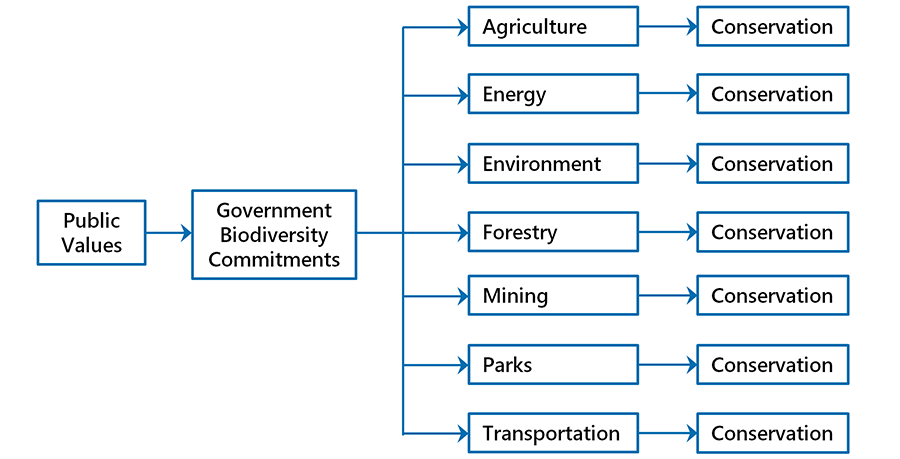Institutional Context
To understand how conservation works in practice, we need to understand the institutional framework that both enables and constrains it. This includes the various agencies involved in land management across the country, as well as existing laws, policies, and commitments.
In Chapter 3, we saw that, outside of protected areas, the legal foundations of ecosystem-level conservation are limited and diffuse. Several provinces, but not all, have enacted some sort of legislation supporting sustainable development. In addition, conservation is often incorporated into laws governing specific types of land use, such as forest harvesting. This type of legislation enables conservation by providing high-level direction and authority for management intervention but typically does not compel specific action. A notable exception is federal and provincial legislation governing environmental assessments, which tends to be relatively prescriptive.
Additional support for ecosystem-level conservation is found in government policy. For example, all federal, provincial, and territorial governments have endorsed the 2020 Biodiversity Goals & Targets for Canada, which features ecosystem approaches (see Box 3.1, Chapter 3). Policy commitments such as these are generally aspirational—they define what we would like to accomplish with respect to conservation, but do not compel action or define accountability for implementation (AGC 2013). In practice, the level of effort put into individual policies reflects the priorities of the political party in power and therefore changes over time.
The implementation of ecosystem-level conservation on public lands is generally overseen by provincial and territorial governments. The federal government’s role is mainly supportive, providing funding and helping to align approaches across the country. In addition, the federal government takes an active role in implementing ecosystem-level conservation within national parks, where the maintenance of ecosystem integrity is mandated by law. On private lands, responsibility for conservation rests mainly with individual landowners.
At the provincial level, responsibility for ecosystem-based conservation is divided among ministries that manage specific industrial sectors (Fig. 7.2). Effective integration among sectoral ministries is usually lacking, and this presents an impediment to the delivery of conservation measures. Provincial fish and wildlife departments are also engaged but have little authority over land use. In most provinces, environment ministries are mainly concerned with issues such as water quality and climate change rather than biodiversity conservation.

Because resource companies and farmers are responsible for most landscape disturbances, they have a central role in ecosystem-level conservation. Many conservation measures involve modifications to their operating practices, and they typically bear the cost of implementing these measures. ENGOs, Indigenous communities, and other stakeholders are also important actors, stimulating conservation action and providing a voice for biodiversity in land-use deliberations.
In the following sections, we will review the main approaches used in ecosystem-level conservation. We will examine how each approach works and what it is intended to accomplish. We will also discuss how these approaches are applied in real-world settings, where conservation objectives must be balanced against competing land-use objectives.
Most ecosystem-level conservation approaches are tailored to specific industrial sectors, and this is how we will discuss them. However, integrated approaches also exist, and we will turn to these at the end of the chapter. Discussion of monitoring and adaptive management will be deferred to Chapter 10 because these approaches are not specific to ecosystem-level conservation.

